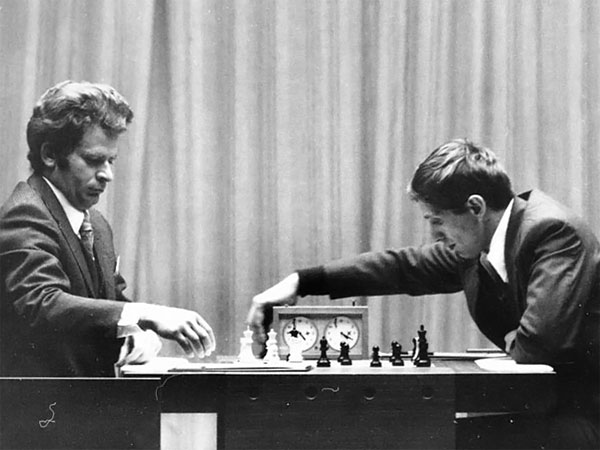


ChessBase 17 - Mega package - Edition 2024
It is the program of choice for anyone who loves the game and wants to know more about it. Start your personal success story with ChessBase and enjoy the game even more.
All black & white photos from the Icelandic Chess Federation Skáksamband Íslands.

This was the stand in the Match of the Century in Reykjavik, forty-five years ago, in our previous report – Fischer had lost the first game traumatically, defaulted in the second game, and then trailing 0-2 in the match picked up four points in the next five games. Spassky was deeply impressed by Fischer's clean win in the sixth game, be he came back to game seven with resolve. He launched a very promising attack which unfortunately collapsed and had him fighting for a draw.
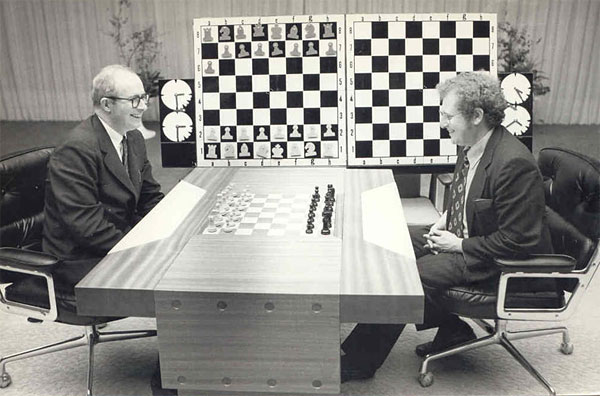
GM Robert Byrne with Chester Fox, who had the media rights for the match at the start, on the stage in Reykjavik
In Chess Life & Review October 1972, p.607, GM Robert Byrne, who was in Reykjavik reporting on the match, wrote:
By game eight the tension of almost continuous defensive play showed up in two Spassky errors. There is some question whether the first was a piece of mistaken judgment or an oversight, but the second was a naive blunder which denied Boris any chance to put up resistance. Otherwise, the game was notable for Bobby's second use of a Queenside opening, the English. It would have been fascinating to see how he intended to proceed from the Maroczy Bind he had set up, but Spassky's mistakes took the game out of normal channels.
Here is Byrne's notes on game eight, as published in CL&R Oct. 1972, p.609.

[Event "Reykjavik World Championship (8)"] [Site "Reykjavik"] [Date "1972.07.27"] [Round "8"] [White "Fischer, Robert James"] [Black "Spassky, Boris Vasilievich"] [Result "1-0"] [ECO "A39"] [WhiteElo "2785"] [BlackElo "2660"] [Annotator "Byrne,Robert"] [PlyCount "73"] [EventDate "1972.07.11"] [EventType "match"] [EventRounds "21"] [EventCountry "ISL"] [SourceTitle "MainBase"] [Source "ChessBase"] [SourceDate "1999.07.01"] 1. c4 {There are probably several reasons for Fischer's adoption of this opening move. In his study of Spassky's games he must have discovered weak points in some of the champion's favorite defenses and wished to exploit them. In game 4, with his favorite 1.e4, Bobby ran into trouble against the Sicilian and perhaps therefore desired a breather so he could think up something new for it.} c5 {Boris doesn't usually play this move, preferring 1...e5. By now he most be so leery of what Fischer has up his sleeve against his known favorites that he is willing to venture only what he is known not to care for.} 2. Nc3 Nc6 3. Nf3 Nf6 4. g3 g6 5. Bg2 Bg7 6. O-O O-O 7. d4 cxd4 {Permitting White to set up the Maroczy Bind is not something of which I approve, though Walter Browne and a few others swear by it. The most solid reply is 7... d6, heading into the Yugoslav Variation of the King's Indian, but I am not sure Boris is familiar with that.} 8. Nxd4 Nxd4 9. Qxd4 d6 10. Bg5 Be6 11. Qf4 { Black was threatening ...Nd5, so the Queen had to move. The most popular retreats are to d3 or h4, but the less usual text is not inferior to them. Anyhow, it puzzled Boris, who took a whole hour to determine if it concealed any gimmicks.} Qa5 12. Rac1 Rab8 {It was still not necessary to defend the b7 pawn, which could not be taken without White having to give up his own in return, but Black is preparing the freeing ...b5.} 13. b3 Rfc8 14. Qd2 a6 15. Be3 {[#]} b5 $2 {Dr. Euwe thought this was a deliberate sacrifice, since Black does get some compensation for the Exchange. Gligoric disagreed, contending that only White has any winning chances now. [According to some reports, Spassky "flinched" when he saw Fischer, next move.—Ed.]} ({The main question is how well Black stands after} 15... Rc7 {recommended by Euwse and Najdorf.} 16. Ba7 Ra8 17. Qe3 $1 Nd7 (17... Ng4 18. Qb6 Qxb6 ({Here} 18... Bxc3 19. Rxc3 Qxc3 {gives White such an enormous positional advantage that it has to be classed as a forced win:} 20. Qxc7 Rxa7 21. Qb8+ {wins.}) 19. Bxb6 Rd7 20. Nd5 {gives White a clear advantage.}) 18. Bd4 {improves the White game, delaying .. .b5 and aiming to get rid of the fianchettoed Bishop.}) {So, in response to the immortal chess question of the late Oscar Tenner—"Did he fall, or was he pushed?"—I tend to favor the latter alternative. The Maroczy Bind is not without teeth.} 16. Ba7 bxc4 17. Bxb8 Rxb8 18. bxc4 Bxc4 19. Rfd1 Nd7 $2 { This is an incredible tactical blunder, after which the game is a flat win for White. Still, it is very difficult to suggest anything for Black against Nd5, with its terrible threat to exchange two minor pieces and thus capitalize on the advantage of the Exchange.} 20. Nd5 Qxd2 21. Nxe7+ $1 {Spassky must have overlooked this zwischenzug.} Kf8 22. Rxd2 Kxe7 23. Rxc4 Rb1+ 24. Bf1 Nc5 25. Kg2 a5 26. e4 Ba1 27. f4 f6 28. Re2 {This seems awkward.} ({At the time I preferred} 28. Be2 {to be followed by Kf3 and Rd1. With the text Bobby threatens e5!}) 28... Ke6 29. Rec2 Bb2 30. Be2 h5 31. Rd2 Ba3 32. f5+ { Decisively opening the position and allowing the Bishop to join the party.} gxf5 33. exf5+ Ke5 34. Rcd4 Kxf5 ({The threat is mate by} 34... -- 35. Rd5+ Ke4 36. Bf3+ Ke3 37. Re2#) 35. Rd5+ Ke6 36. Rxd6+ Ke7 37. Rc6 1-0
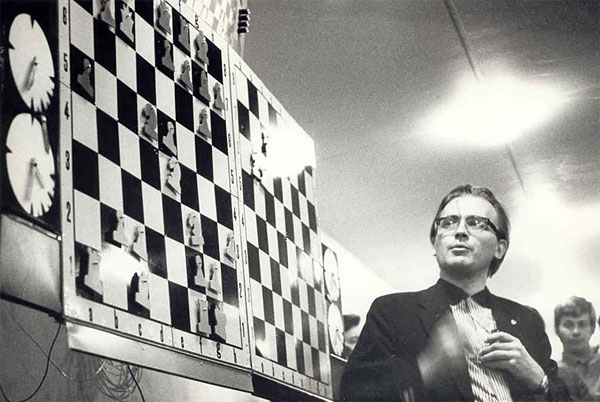
The legendary Bent Larsen, whom Fischer had demolished in the Candidates match in 1971, provided commentary for chess fans in Reykjavik
About the next encounter Robert Byrne wrote:
Game 9 was the shortest, quietest draw of the match so far. After the blunders of round 8, perhaps Spassky needed to demonstrate to himself that he could not be just bowled over. Many grandmasters aim for a draw in the next contest after a bad loss to fight the feeling that they will never do anything right again. Nevertheless, the opening is of considerable theoretical value, for Fischer introduced an enterprising pawn shot at his ninth move, transplanting an idea from the Gruenfeld Defense. Boris made some attempt to demonstrate weaknesses on Fischer's Queenside, but without getting anywhere against Fischer's accurate tactical defense. That left no other conclusion but a split point.
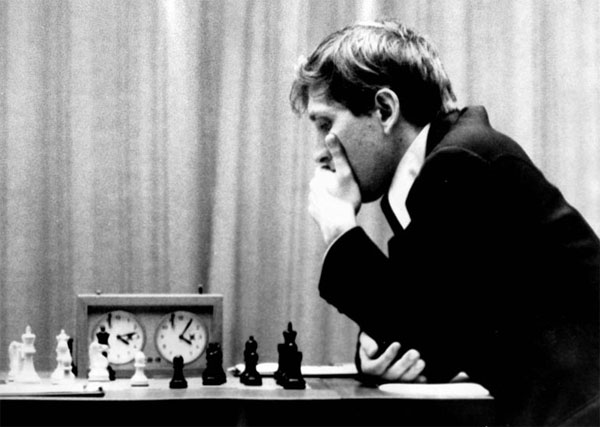

[Event "Reykjavik, World Championship"] [Site "Reykjavik"] [Date "1972.08.01"] [Round "9"] [White "Spassky, Boris Vasilievich"] [Black "Fischer, Robert James"] [Result "1/2-1/2"] [ECO "D41"] [WhiteElo "2660"] [BlackElo "2785"] [Annotator "Byrne,Robert"] [PlyCount "58"] [EventDate "1972.07.11"] [EventType "match"] [EventRounds "21"] [EventCountry "ISL"] [SourceTitle "MainBase"] [Source "ChessBase"] [SourceDate "1999.07.01"] 1. d4 Nf6 2. c4 e6 3. Nf3 d5 4. Nc3 c5 {While this move has been accepted as the equalizer for about 40 years, recently Spassky (in his 1969 match with Petrosian) and Polugaevsky have brought it under the hammer once again. In the match opener, Bobby went for the Nimzo-Indian 4...Bb4 instead, but the text move has always ranked high in his estimation.} 5. cxd5 Nxd5 6. e4 ({The alternative, favored by Najdorf and a number of others (including me), is} 6. e3 {which leads to positions roughly characteristic of the Queen's Gambit Accepted. Not since his game with me in the 1962 U.S. Championship has Bobby been in any trouble against it. Spassky, with his Tarrasch-like play, prefers the classical pawn center arising from the text.}) 6... Nxc3 7. bxc3 cxd4 8. cxd4 Nc6 9. Bc4 b5 $5 {It makes a lot of sense strategically to get the Black Queenside in motion. since his compensation for the enemy center is the pawn majority on that wing in the endgame. Tactically, however, it looks dangerous to advance like this without first completing development. The next six moves demonstrate that Bobby's innovation has been well prepared. Of course, the pawn cannot be taken at once because of 10...Qa5ch.} 10. Bd3 Bb4+ 11. Bd2 Bxd2+ 12. Qxd2 a6 13. a4 O-O {The first of Bobby's tactical points.} 14. Qc3 { The Queen sticks out like a sore thumb on the open file, but} ({but} 14. Qb2 Qa5+ 15. Nd2 Qb4 {is too strong for Black.}) (14. axb5 Nxd4 15. bxa6 Nb3 { is disastrous for White.}) 14... Bb7 15. axb5 axb5 {The pawn is without visible means of support, but its defense is indirect.} 16. O-O (16. Rxa8 Qxa8 17. Bxb5 Na7 {followed by the capture of the KP.}) ({The same result occurs on } 16. Bxb5 Rxa1+ 17. Qxa1 Nb4 18. Qa4 Qe7 {because it is impossible for White to defend the KP and threat of 19...Ra8 and 20...Ra1+ simultaneously.}) 16... Qb6 17. Rab1 ({Probably Dr. Euwe is right in claiming that the only may for White to try for sharp play is} 17. Rad1 {followed by Bb1 with the idea of a Kingside attack. However, Boris has undoubtedly judged the position as equal and is reconciled to a draw with the least fuss. After the text move, the weakness of the Black QNP and the White QP are in balance.}) 17... b4 18. Qd2 ( {There is some difference of opinion about the endgame resulting from} 18. d5 exd5 19. exd5 bxc3 20. Rxb6 Na5 21. d6 {Gligoric feels that White stands better, while Euwe believes it to be a draw. I don't think there is anything in it for White after} Bd5) 18... Nxd4 (18... Rfd8 {which runs into} 19. d5 $1 {which wins the QNP and the game.}) 19. Nxd4 Qxd4 20. Rxb4 Qd7 21. Qe3 Rfd8 { The game could be given up as a draw here, except that throughout this match both players insist on playing everything out to the bitter end.} ({Nor was there a chance in} 21... Ra3 22. Qb6 ({[Actually} 22. Bb5 Rxe3 23. Bxd7 Rxe4 24. Rxb7 {-- ed.]})) 22. Rfb1 Qxd3 23. Qxd3 Rxd3 24. Rxb7 g5 25. Rb8+ Rxb8 26. Rxb8+ Kg7 27. f3 Rd2 28. h4 h6 29. hxg5 hxg5 1/2-1/2
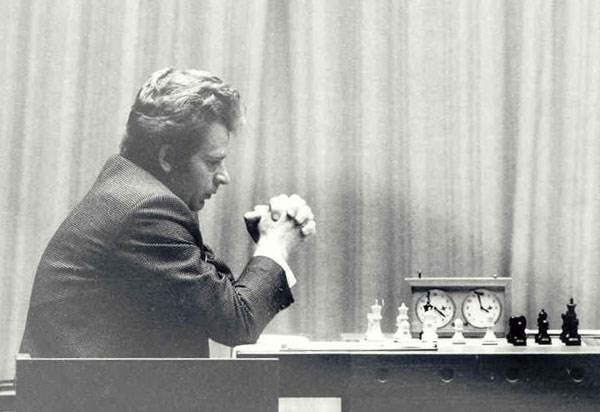
In Bobby Fischer against the Rest of the World Brad Darrach writes: "In the tenth game, nothing worked for Spassky. After an even opening, Bobby sprang a strong surprise attack. Spassky began patting his forehead lightly with a folded handkerchief. Bobby swung his chair from side to side and smiled. If he moved three games ahead, could Spassky play on? The crowd, disliking Bobby, admiring Spassky, did not want to see the blow fall but no one could look away. 'There is a fascination in executions,' Gligoric said. This one was slow but thorough."
In Garry Kasparov on Fischer (My Great Predecessors Part IV) Kasparov writes: "In the 10th game the American reverted to his favourite 1 e4 and played, in my view, the best game of the match (I know that Bondarevsky was also of this opinion). This was a battle not for life, but to the death, and Black also fought worthily. This is why I rate this game higher than the 6th: here there was more of a fight, more resistance!"

[Event "Reykjavik World Championship (10)"] [Site "?"] [Date "1972.08.03"] [Round "?"] [White "Fischer, Robert James"] [Black "Spassky, Boris V"] [Result "1-0"] [ECO "C95"] [WhiteElo "2785"] [BlackElo "2660"] [Annotator "ChessBase"] [PlyCount "111"] [EventDate "1972.??.??"] 1. e4 e5 2. Nf3 Nc6 3. Bb5 a6 4. Ba4 Nf6 5. O-O Be7 6. Re1 b5 7. Bb3 d6 ({ In Santa Monica 1966 Spassky played} 7... O-O 8. c3 d5 {the Marshall Attack leading to draw. He had used the same system with Tal in the Candidates Match 1965, drawing all his games.}) 8. c3 O-O 9. h3 Nb8 {The Breyer Variation, a favourite of Spassky.} ({In the Havana Olympiad he had played} 9... h6 { (Smyslov Variation) and the game was a hard-fought draw. However, the variation had received some hard knocks in the games Fischer-Gligoric, Rovinj/ Zagreb 1970 and Fischer-Ivkov, 1970 Interzonal.}) 10. d4 Nbd7 11. Nbd2 ({ Fischer decided not to play his old line} 11. Nh4 {on account of} exd4 12. cxd4 Nb6 13. Nd2 c5 $11 {that led to an easy draw in Robert Byrne-Boris Spassky, Moscow 1971.}) 11... Bb7 12. Bc2 Re8 13. b4 {This plan preventing the freeing advance ...c5 that was popular in those days.} ({In his own games with white Spassky had preferred} 13. Nf1 {and currently it is in vogue.}) 13... Bf8 14. a4 Nb6 15. a5 Nbd7 16. Bb2 Qb8 {A novelty in this position. Otherwise the idea is known. The move indirectly defends e5 and targets White's b-pawn. However, its drawback is that it shuts out the QR.} ({Later} 16... Rb8 {followed by... Ba8 came to be seen as the antidote to White's play. Consequently the line with 13. b4 was given up.}) 17. Rb1 {indirectly defending the b-pawn} ({Here} 17. c4 bxc4 18. Nxc4 $5 {deserves attention. If} (18. Ba4 {recommended by Timman and Kasparov is met by} exd4 19. Nxd4 (19. Bxd4 Re7 $11) 19... Ne5 20. Bxe8 Qxe8 $44) 18... exd4 19. Qxd4 $14 {White has more space and better development.}) 17... c5 18. bxc5 {The battle is for the control of e5 and this move strikes at d6, the heart of its base.} dxc5 19. dxe5 Nxe5 20. Nxe5 Qxe5 21. c4 {calling into question Black's entire plan initiated with 16...Qb8.} Qf4 22. Bxf6 (22. cxb5 axb5 23. e5) 22... Qxf6 23. cxb5 Red8 $5 {Spassky offers a pawn for active counterplay.} ({If} 23... axb5 24. Rxb5 Ba6 25. e5 $1 Rxe5 26. Rb6 Qe7 27. Rxe5 Qxe5 28. Nf3 $14) 24. Qc1 $1 (24. Qe2 $2 {is tactically flawed on account of} axb5 $1 25. Rxb5 Ba6 26. e5 Qc6 27. e6 Qxe6 28. Qxe6 fxe6 29. Rb2 Rxd2 30. Bxh7+ Kxh7 31. Rxd2 Bc4 $17) 24... Qc3 (24... axb5 25. Rxb5 Ba6 26. Rb6 Qc3 $13 {led to a tense draw in Vasiukov-Smejkal, Polanica Zdroj 1972.}) 25. Nf3 Qxa5 26. Bb3 axb5 27. Qf4 {The point of White's 24th move.} Rd7 (27... c4 $2 {loses a pawn to} 28. Bxc4 $1 bxc4 29. Rxb7 $14) 28. Ne5 Qc7 29. Rbd1 Re7 $2 {anxious to defend the second rank and yet the move turns insufficient} ({He had to play} 29... Rad8 $1 30. Bxf7+ Rxf7 31. Qxf7+ Qxf7 32. Nxf7 Rxd1 33. Rxd1 Bxe4 34. Ng5 Bf5 (34... Bc2 35. Rd8 b4 36. Ne6 Kf7 37. Nxf8 b3 38. Rb8 Ke7 $3) 35. Rd5 h6 36. Rxf5 hxg5 37. Kf1 (37. Rxg5 b4 $11) 37... Be7 $11 {analysis pioneered by Olafsson and refined by Timman and Kasparov}) 30. Bxf7+ $1 Rxf7 {forced} (30... Kh8 $4 {runs into} 31. Ng6+ $1 hxg6 32. Qh4#) 31. Qxf7+ Qxf7 32. Nxf7 {The point. White exploits the weak second rank.} Bxe4 ({If } 32... Kxf7 $2 33. Rd7+ $16) 33. Rxe4 Kxf7 34. Rd7+ Kf6 35. Rb7 Ra1+ $6 { By now Spassky was in time trouble. Here he tries to activate his rook and bishop and at the same time keep away the white king from his advancing pawns. Unfortunately, it falls short of expectations.} ({Larsen offered} 35... b4 $1 { and it sets more problems for White. However, after} 36. Rb6+ Kf7 ({If} 36... Kf5 37. f3 {(Nei) preparing h4 followed by Rbe6 forming a mating net should win.}) 37. f4 Re8 38. Rxe8 Kxe8 39. Rb7 {White has the upper hand, but no clear win according to Timman and Kasparov.}) 36. Kh2 Bd6+ 37. g3 b4 38. Kg2 h5 ({The suggestion of Krogius and Nei} 38... Kf5 39. Rh4 Be5 {is refuted by Timman.} 40. Rh5+ $1 Ke6 41. Rb6+ Bd6 ({or} 41... Kd5 42. f4 $18) 42. Rxc5 $18) 39. Rb6 Rd1 40. Kf3 Kf7 ({or} 40... g5 41. Ke2 Rd5 42. g4 hxg4 43. hxg4 Kf7 44. Rb7+ {followed by 45.Rd7 wins.}) 41. Ke2 {The sealed move. During the adjournment Spassky and his seconds could find no way of saving the game.} Rd5 42. f4 $1 g6 43. g4 hxg4 44. hxg4 g5 {This attempt to prevent g4-g5 does not alter the outcome of the game.} (44... Kf6 45. Rb5 Kf7 46. g5 ({not} 46. Rexb4 $2 cxb4 47. Rxd5 Bxf4 $11 {with a theoretical draw}) 46... Rf5 47. Ke3 $18 { Soon Black runs out of moves, either falling into a mating net or losing his queenside pawns.}) 45. f5 Be5 46. Rb5 $1 {Pinning the c-pawn so that its companion can be captured.} Kf6 ({not} 46... Bd4 47. Rb7+ Kf8 48. Re6 $18) 47. Rexb4 Bd4 48. Rb6+ Ke5 49. Kf3 $1 {A little joke.} Rd8 ({If} 49... cxb4 $4 50. Re6#) 50. Rb8 Rd7 51. R4b7 Rd6 52. Rb6 Rd7 53. Rg6 Kd5 54. Rxg5 Be5 55. f6 Kd4 56. Rb1 $1 {and Spassky resigned.} (56. Rb1 Bxf6 57. Rd1+ Kc4 58. Rxc5+ Kxc5 59. Rxd7 $18) 1-0
Spassky's second Krogius said: "After Boris’ defeat in the 10th game, the anxiety in Moscow increased sharply… The directors of the USSR Sports Committee and the Chess Federation suggested that I should fly to Moscow for 2-3 days, to explain Spassky’s poor play. Fortunately, for me, Boris categorically rejected the suggestion. What would I have said to our sports directors? There was no point in crying over spilt milk. There were hopes of revival by Spassky, and the opportunities for this, if they existed, lay in Reykjavik, and not in Moscow."
Brad Darrach tells us that during this game two Icelanders, a father and son, observed a man who had been conversing in Russian sitting close to the stage. When the game started he took something out of his pocked and put it into his mouth. "Then a thin rigid tube emerged between his lips and pointed towards the players." Whenever an Icelandic policeman strolled by the tube was instantly drawn back into the man's mouth, and when the policeman was gone it reappeared. The Icelandic police investigated, but the perpetrator (and two apparent assistants) disappeared after the game, and were soon recalled to Russia. It was speculated that they had launched an attempt to disturb Fischer with a high-pitched whistle, one that was not normally audible to the human ear. But Bobby was said to have hyperacusis, an increased sensitivity to certain frequencies. All of this is speculation, but it is plausible as hell.

Boris Spassky scored just 1½ points in games 3-10 [photo: Skáksamband Íslands]

The score was now 6½-3½ for Fischer. The champion had not won since the first game, and of the last eight points had only scored 1½ points – from three draws. Robert Byrne predicted: "Unless Spassky can marshall his resources for a striking comeback, this match is not going to last the full 24 games."
Here are the times for the three games, as recorded by Lawrence Stevens, who visited the match in Reykjavik and jotted them down from the video screens:
|
Game 8, July 27, 1972 Fischer Spassky (ar) indicates a player's arrival |
Game 9, August 1st, 1972
Spassky Fischer |
Game 10, August 3-4, 1972 Fischer Spassky |
In game eight Spassky took 59 minutes for move 11, which was by far the longest time taken in any move of this 21 game match.
In game nine when Fischer appeared, Spassky had already left and did not come back until four minutes after Fischer's move.
In game ten Fischer sealed his 41st move and his clock was then advanced 20 minutes by the arbiter to complete the five hour playing session. The arbiter started the second session on time the next day, opening the sealed envelope, playing Fischer’s sealed 41st move on the board, and starting Spassky’s clock. Neither player was present. Fischer arrived first, 8 minutes late. Spassky was 13 minutes late.
The next time control was 3:30 at move 56.
Some of our younger readers – including grandmasters in their early teens, whose parents were not alive when all of the above transpired – may not be familiar with adjournments in chess. The rules that were in place at the Reykjavik World Championship are described in full detail by Lawrence in his Crack Team blog:
In the days of adjournments, the arbiter would, at the correct time, inform the player on the move that his next move is to be a sealed move. This means that, after due reflection, instead of making his move on the board, the player writes his move in private and puts it into the arbiter’s envelope, and seals it. The arbiter records the clock times and the position, typically on the outside of the envelope, for the game’s later resumption. The arbiter then impounds this envelope, maintaining custody until the game is resumed. When the game is resumed, the arbiter prepares the clocks and board, opens the envelope, plays the sealed move, and then presses that player’s clock to start the new session of play.
When does the arbiter prompt a player to make the sealed move? At the end of the playing session. In this case, when both players have completed at least 40 moves, AND five total hours have accumulated on the player’s clocks. If both players have completed 40 moves, and five hours have not yet accumulated, then the player to move can control the situation, using it to his advantage.
If that player wants to seal his next move, he can decide on it and then just wait until the arbiter prompts him to do it. Actually, if the player knows his next move and does not want to wait, he can ask the arbiter for the envelope, seal his move, and the arbiter will deduct time off his clock to complete the necessary five total elapsed hours. This extra elapsed time is seen on the clock when the game is resumed.
Instead, if the player wants his opponent to seal the move, he can decide on his own move and wait until just before the five hours is finished. Then he makes the move. The opponent now has to either move before the session ends, or be prompted by the arbiter to seal his move.
The games of the match began at 5 PM, and the adjournments began at 2:30 PM the next day. The first session was 5 hours, and the following sessions, if necessary, were 4 hours, with a time control of 16 moves per hour. Thus time controls were at move 40 in the first session and at moves 56 and 72 in the second session. No game extended into a third session in this match.
Bobby Fischer in Iceland – 45 years ago (1)
In the final week of June 1972 the chess world was in turmoil. The match between World Champion Boris Spassky and his challenger Bobby Fischer was scheduled to begin, in the Icelandic capital of Reykjavik, on July 1st. But there was no sign of Fischer. The opening ceremony took place without him, and the first game, scheduled for July 2nd, was postponed. Then finally, in the early hours of July 4th, Fischer arrived. Frederic Friedel narrates.
Bobby Fischer in Iceland – 45 years ago (2)
The legendary Match of the Century between Boris Spassky and Bobby Fischer was staged in the Laugardalshöllin in Reykjavik. This is Iceland’s largest sporting arena, seating 5,500, but also the site for concerts – Led Zeppelin, Leonard Cohen and David Bowie all played there. 45 years after the Spassky-Fischer spectacle Frederic Friedel visited Laugardalshöllin and discovered some treasures there.
Bobby Fischer in Iceland – 45 years ago (3)
On July 11, 1992 the legendary Match of the Century between Boris Spassky and Bobby Fischer finally began. Fischer arrived late, due to heavy traffic. To everybody's surprise he played a Nimzo instead of his normal Gruenfeld or King's Indian. The game developed along uninspired lines and most experts were predicting a draw. And then, on move twenty-nine, Fischer engaged in one of the most dangerous gambles of his career. "One move, and we hit every front page in the world!" said a blissful organiser.
Bobby Fischer in Iceland – 45 years ago (4)
7/16/2017 – The challenger, tormented by the cameras installed in the playing hall, traumatically lost the first game of his match against World Champion Boris Spassky. He continued his vigorous protest, and when his demands were not met Fischer did not turn up for game two. He was forfeited and the score was 0-2. Bobby booked a flight back to New York, but practically at the very last moment decided to play game three – in an isolated ping-pong room!
Bobby Fischer in Iceland – 45 years ago (5)
7/21/2017 – After three games in the Match of the Century the score was 2:1 for the reigning World Champion. In game four Spassky played a well-prepared Sicilian and obtained a raging attack. Fischer defended tenaciously and the game was drawn. Then came a key game, about which the 1972 US Champion and New York Times and Chess Life correspondent GM Robert Byrne filed reports. In Reykjavik chess fan Lawrence Stevens from California did something extraordinary: he manually recorded the times both players had spent on each move.
Bobby Fischer in Iceland – 45 years ago (6)
7/26/2017 – In the sixth installment of our series we offer readers a glimpse of what had been happening behind the scenes of “The Match of The Century”, especially in the Russian camp. A tense Boris Spassky, cajoled by seconds Efim Geller and Nikolai Krogius, nevertheless failed to perform to the dismay of his friends and admirers. It’s also the story of a gamble that could have hurtled Bobby down the precipice in that fateful Game 6 of the match. A cautionary tale and object lesson for aspiring players.
Master Class Vol.1: Bobby Fischer
No other World Champion was more infamous both inside and outside the chess world than Bobby Fischer. On this DVD, a team of experts shows you the winning techniques and strategies employed by the 11th World Champion.
Grandmaster Dorian Rogozenco delves into Fischer’s openings, and retraces the development of his repertoire. What variations did Fischer play, and what sources did he use to arm himself against the best Soviet players? Mihail Marin explains Fischer’s particular style and his special strategic talent in annotated games against Spassky, Taimanov and other greats. Karsten Müller is not just a leading international endgame expert, but also a true Fischer connoisseur.